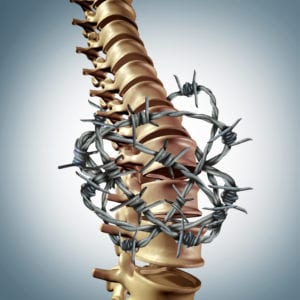 People who feel good take a lot for granted. Approximately 50 million US adults experience chronic pain, which is pain that lasts more than three months. The pain can be nagging, mild, or more severe. In 2016, a report by the National Health Institute found that 20% of chronic pain patients endure high impact chronic pain (HICP). With HICP, a person cannot perform daily activities without experiencing pain, so quality of life is significantly impaired.
People who feel good take a lot for granted. Approximately 50 million US adults experience chronic pain, which is pain that lasts more than three months. The pain can be nagging, mild, or more severe. In 2016, a report by the National Health Institute found that 20% of chronic pain patients endure high impact chronic pain (HICP). With HICP, a person cannot perform daily activities without experiencing pain, so quality of life is significantly impaired.
The National Institute of Health estimates that 83% of HICP patients cannot work, and they have much higher health costs than the average person. On medical care, programs, and lost production, about $560 billion is lost annually in our country because of chronic pain.
For people with HICP, simple activities, like doing the laundry, shopping at the mall, gardening, cooking, or even going out to eat may be painful. This same population is prone to a higher incidence of anxiety, depression, cognitive challenges, and fatigue.
Who wants to go shopping when you’re depressed, foggy-headed, tired, and hurting?
Treatment Options for Chronic Pain
Chronic pain can be related to an injury, a health condition, or an unknown source. Treatment may include any combination of the following.
- Taking pressure off damaged joints, including those of the spine, can help reduce pain in some situations. Pressure reduction can include weight loss and/or lightened activity.
- Exercise can strengthen muscles and release positive hormones that help us feel better. Regular exercise for at least 30 minutes, 3-7 times per week is the best practice. For low impact, try water aerobics, yoga, or Tai Chi.
- A doctor may suggest over-the-counter analgesics like aspirin or non-steroidal anti-inflammatory drugs (NSAIDs) like naproxen, acetaminophen, ibuprofen. Using NSAIDs long-term can create complications in the digestive system, as well as kidney and heart problems.
- Heat and cold therapy are effective for some patients.
- Medications known as topical analgesics, including brands such as Aspercreme, Tiger Balm, and Icy Hot, can provide temporary relief in the area of pain, for some patients.
- A personal TENS unit, properly used, may temporarily reduce or alleviate pain.
- For the spine, traction may help reduce pain. Some chiropractors and physicians offer this treatment in- office.
- Physical therapy remains an extremely common recommendation by doctors for patients with chronic pain. Improving range of motion and strengthening the core will redistribute some of the weight put on the spine. A PT may also recommend stretching exercises to practice at home, ice and heat therapy, or massage.
- If these treatments are not effective, a pain management doctor may prescribe a narcotic, such an opioid, for short-term use. These include hydrocodone, codeine, oxycodone, and morphine. They are highly addictive and tolerance can build up, making the patient require a higher dosage to maintain similar results. Opioid addiction is a serious problem in the United States, so consider alternatives if possible.
- The doctor may add an anticonvulsant, like gabapentin, to your medications to treat radicular pain.
- Antidepressants like serotonin and norepinephrine reuptake inhibitors can help relieve some cases of chronic pain in the back.
- A muscle relaxant can resolve muscle spasms related to an area of pain, such as muscles that surround a degenerative disc.
- Steroid injections are often suggested, orally for 7-10 days or by injection at the site of the pain source. These offer temporary relief, ranging from weeks to months, depending upon the patient.
- Acupuncture targets meridians in the body, found along the nerve pathways. The practice is usually comfortable, and it stimulates blood flow while also signaling the release of endorphins.
- Chiropractic therapy involves skeletal manipulation to bring balance back to the underlying support of the body. Oftentimes, a chiropractor can effectively relieve a patient’s pain, without using narcotics.
Non-Invasive, Effective HICP Treatment with Chiropractic Acupuncture
At Doyle Chiropractic and Acupuncture in Roanoke, near Trophy Club and Justin, Dr. Cody Doyle is a licensed Doctor of Chiropractic Medicine. He’s also a certified acupuncturist. Throughout his career, Dr. Doyle has researched treatments for chronic pain. He offers treatment in the evolving field of chiropractic acupuncture. In some cases, acupuncture with chiropractic and herbal medicine yield outstanding results for chronic pain. Other patients respond best to chiropractic spinal manipulation and a regimen of home exercises.
Some patients use traditional medicine while undergoing treatment with Dr. Doyle, in an effort to find an alternative treatment that will not involve medications. Because all medications have side effects, and some build up in the body to cause issues over time, seeking alternative treatment for chronic pain is wise and practical.
TESTIMONIAL
“My pain management doctor recommended spinal and AI joint injections for my leg pain. Before undergoing the procedure, and because I knew that any relief the cortisone provided would be short-lived, I opted to visit Dr. Doyle. He has my chiropractor and acupuncturist for a few years, for other issues. This is hard to believe, but In one visit – just one visit! – my leg pain was relieved. Praise God and thanks to Dr. Doyle. I literally hobbled into the office in pain and walked out, after chiropractic and acupuncture appointment.”
– Shauna Duty, Roanoke, Tx
Your insurance company may reimburse for part or all of your chiropractic and acupuncture treatment at Doyle Chiropractic and Acupuncture. However, Dr. Doyle keeps his fees affordable so that pain management care is accessible. If you suffer from daily pain, call 817-767-5430 or email us today for a consultation.